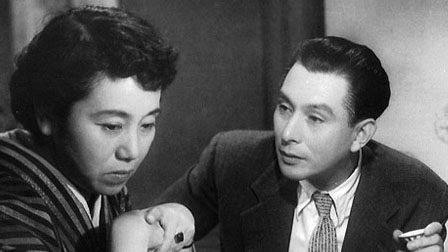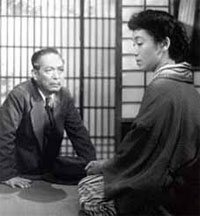From the February 24, 2006 Chicago Reader. — J.R.
Late Chrysanthemums
**** (Masterpiece)
Directed by Mikio Naruse
Written by Sumie Tanaka and Toshiro Ide
With Haruko Sugimura, Sadako Sawamura, Chikako Hosokawa, Yuko Mochizuki, Ken Uehara, Hiroshi Koizumi, and Ineko Arima
Depressing movies with unhappy endings are often seen as offering a bracing contrast to the standard Hollywood fare. This may help explain the appeal of Brokeback Mountain, whose drafts of misery are seen by some people as daringly honest and authentic.
I wonder. Some lives are full of misery, but this doesn’t mean movies that reflect them are automatically more truthful. If the shepherds played by Heath Ledger and Jake Gyllenhaal had sustained a happy, loving relationship over several decades in spite of everything, Brokeback Mountain might have been truly daring — and it wouldn’t have been less believable. The impulse to privilege the dark is hardly new; in prerevolutionary Russian cinema, tragic plots ending in suicide were so common and popular that some Hollywood imports with happier endings were revised to make them more “commercial.” I would argue that a certain complacency surrounds some of these doom-ridden scenarios, especially ones that suggest social change is impossible — a vested interest in the status quo, even conservatism, seems to lurk behind the apparent apoliticism.
Having seen 10 of the 19 films by Mikio Naruse (out of a career total of 89) screening at the Gene Siskel Film Center’s retrospective that started in January, most of them post-World War II features, I can think of only one — Travelling Actors (1940), an uncharacteristic comedy about two Kabuki actors who play a horse — that might cheer someone up. (None of his early silent films, many of which are comedies, is in the retrospective.) Steeped in lower-middle-class life, Naruse’s most celebrated films usually feature plots that disappoint the modest expectations of their working-stiff characters. Even Travelling Actors, also screening this week, is preoccupied with deprivations tied to class.
Over the years the appreciations written by Naruse’s most eloquent American defender, Philip Lopate, eagerly embraced the director’s defeatism, which I found alienating. “Naruse’s forlorn flavor of existence can become addictive,” he wrote. “One of the charms of Naruse’s art is its earned pessimism. It takes for granted that life is unhappy; therefore, we can relax in the possession of sadness, acquiesce from the start to the fate of disenchantment.” A similar hopelessness permeates Lopate’s recent dismissal in the Nation of James Agee’s most adventurous, contentious, and politically acute writing; he calls Let Us Now Praise Famous Men “unreadable” and finds the posthumously published essay “America, Look at Your Shame!” (excluded from the Library of America’s selection of Agee’s essential writing, which Lopate deems “excellent”) unworthy of mention.
Lopate’s attitude seems tied more to an American context than a Japanese one. And in the case of Naruse’s masterpiece Late Chrysanthemums (1954), what’s most impressive isn’t its fatalism or resignation but its energy and vivid portraiture.
Naruse (1905-’69) is less known for his visual style than either Yasujiro Ozu or Kenji Mizoguchi, though his utter lack of sentimentality has stylistic consequences — his abrupt cutting between sequences, for example, prevents us from lingering over the pathos of his characters and sometimes has the jolting effect of a door slammed in our face. His work is most recognizable for the vividness and conviction he shows in representing these people and for the extraordinary performances he elicits from the actors portraying them.
The writer Naruse most liked to adapt was Fumiko Hayashi, a celebrated fiction writer who died in 1951, the year Naruse finished Repast, his first adaptation of her work. Her stories were the source of six of his better-known features, including two of the most celebrated, Late Chrysanthemums and Floating Clouds (1955). Late Chrysanthemums is based on three stories about aging former geishas, and one of the most remarkable things about the screenplay by Sumie Tanaka and Toshiro Ide is how seamlessly they’re combined.
Kin (Haruko Sugimura), a childless ex-geisha, has become a greedy loan shark, and two of her clients are Tamae (Chikako Hosokawa) and Tomi (Yuko Mochizuki), former colleagues and widows with grown children. Tamae’s son has become a paid escort for an older woman — the reason his mother cringes when he tries to help her out with expenses — and Tomi’s daughter works at a casino and has just become engaged to a wealthy man she met there. None of the three middle-aged women has a man in her life, though they don’t seem to mind, having had their fill of catering to clients. Yet we’re also keenly aware that they’re increasingly lonely.
These women are as vivid as the characters in Erich von Stroheim’s Greed — not just because they’re obsessed with money, but because Naruse has an uncanny feeling for extraneous detail. Twenty years ago Dave Kehr aptly noted in this paper that Late Chrysanthemums “is a masterpiece of narrative construction,” yet paradoxically many of the things that register most indelibly aren’t essential to the story. Furthermore, although there’s nothing attractive or likable about any of the characters, they have a passion that’s fascinating, and we can’t anticipate any of their moves.
Kin is plainly a hateful, embittered miser who doesn’t mind hounding or even evicting the people who owe her money. But Naruse refrains from treating her as a simple villain, and what’s most memorable about her is the way her few vestiges of romantic hope are dashed by a visit from a former lover (she unexpectedly and awkwardly delivers an offscreen internal monologue) and the warm, animated way she pantomimes her household instructions to her deaf-mute maid — a side of her personality she shows to practically no one else. What’s most memorable about Tomi is the way she secretly mocks her daughter for primping in a mirror next to the table where they’re having lunch and the two times she sneezes during the same meal — a detail that’s about as gratuitous as one can imagine in narrative terms, yet Naruse somehow makes it seem essential.
Underplaying everything that might be construed as a dramatic climax, Naruse imbues the smallest gestures of these women with the weight of their entire personalities, so that the “action” becomes the moments when they’re most clearly being themselves. A rude sneeze carries the full force of an ugly, tired woman’s unexpressed feeling that she’s about to be abandoned, and when Kin quietly burns a photograph of a man she once loved we sense that her soul is also being obliterated.





